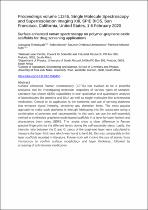 ResearchSpace
ResearchSpace
Surface enhanced raman spectroscopy on polymer-graphene oxide scaffolds for drug screening applications
JavaScript is disabled for your browser. Some features of this site may not work without it.
- ResearchSpace
- →
- Research Publications/Outputs
- →
- Journal Articles
- →
- View Item
| dc.contributor.author |
Thobakgale, Setumo L

|
|
| dc.contributor.author |
Manoto, Sello L

|
|
| dc.contributor.author |
Ombinda-Lemboumba, Saturnin

|
|
| dc.contributor.author |
Mthunzi-Kufa, Patience

|
|
| dc.date.accessioned | 2021-04-06T09:05:16Z | |
| dc.date.available | 2021-04-06T09:05:16Z | |
| dc.date.issued | 2020-05 | |
| dc.identifier.citation | Thobakgale, S.L., Manoto, S.L., Ombinda-Lemboumba, S. & Mthunzi-Kufa, P. 2020. Surface enhanced raman spectroscopy on polymer-graphene oxide scaffolds for drug screening applications. http://hdl.handle.net/10204/11945 . | en_ZA |
| dc.identifier.isbn | 978-1-51063255-4 | |
| dc.identifier.uri | https://doi.org/10.1117/12.2546455 | |
| dc.identifier.uri | https://www.spiedigitallibrary.org/conference-proceedings-of-spie/11246/2546455/Surface-enhanced-raman-spectroscopy-on-polymer-graphene-oxide-scaffolds-for/10.1117/12.2546455.full?SSO=1 | |
| dc.identifier.uri | http://hdl.handle.net/10204/11945 | |
| dc.description.abstract | Surface enhanced Raman spectroscopy (SERS) has evolved to be a powerful analytical tool for investigating molecular properties of various types of samples. Literature has shown SERS capabilities in both qualitative and quantitative analysis of biomolecules like proteins and DNA as well as single molecules like antiretroviral medication. Central to its application is the synthesis and use of sensing platforms that enhance signal intensity, sensitivity and detection limits. The most popular approach to make such platforms is through fabricating thin film substrates using a combination of polymers and nanomaterials. In this work, we use the self-assembly method to synthesize graphene oxide based scaffolds in a layer-by-layer fashion and characterize them using SERS. The results show a clear difference in Raman spectral fingerprint for the different layers during the self-assembly steps. Lastly, the intensity ratio between the D and G bands of the graphene layer were calculated to measure the layer thickness which was found to be 0.65, this was comparable to thin layer scaffolds reported in literature. Future work will involve the use of atomic force microscopy to confirm surface morphology and layer thickness, followed by screening of antiretroviral medication. | en_US |
| dc.format | Abstract | en_US |
| dc.language.iso | en | en_US |
| dc.source | Proceedings volume 11246, Single Molecule Spectroscopy and Superresolution Imaging XIII, SPIE BIOS, San Francisco, California, United States, 1-6 February 2020 | en_US |
| dc.subject | Graphene oxide | en_US |
| dc.subject | Self assembly method | en_US |
| dc.subject | Surface enhanced Raman spectroscopy | en_US |
| dc.title | Surface enhanced raman spectroscopy on polymer-graphene oxide scaffolds for drug screening applications | en_US |
| dc.type | Conference Presentation | en_US |
| dc.description.pages | 11pp | en_US |
| dc.description.note | © 2020 SPIE. Due to copyright restrictions, the attached PDF file contains the abstract of the full-text item. For access to the full-text item, please consult the publisher's website: https://doi.org/10.1117/12.2546455 | en_US |
| dc.description.cluster | Manufacturing | |
| dc.description.impactarea | Bio-photonics | en_US |
| dc.identifier.apacitation | Thobakgale, S. L., Manoto, S. L., Ombinda-Lemboumba, S., & Mthunzi-Kufa, P. (2020). Surface enhanced raman spectroscopy on polymer-graphene oxide scaffolds for drug screening applications. http://hdl.handle.net/10204/11945 | en_ZA |
| dc.identifier.chicagocitation | Thobakgale, Setumo L, Sello L Manoto, Saturnin Ombinda-Lemboumba, and Patience Mthunzi-Kufa. "Surface enhanced raman spectroscopy on polymer-graphene oxide scaffolds for drug screening applications." <i>Proceedings volume 11246, Single Molecule Spectroscopy and Superresolution Imaging XIII, SPIE BIOS, San Francisco, California, United States, 1-6 February 2020</i> (2020): http://hdl.handle.net/10204/11945 | en_ZA |
| dc.identifier.vancouvercitation | Thobakgale SL, Manoto SL, Ombinda-Lemboumba S, Mthunzi-Kufa P, Surface enhanced raman spectroscopy on polymer-graphene oxide scaffolds for drug screening applications; 2020. http://hdl.handle.net/10204/11945 . | en_ZA |
| dc.identifier.ris | TY - Conference Presentation AU - Thobakgale, Setumo L AU - Manoto, Sello L AU - Ombinda-Lemboumba, Saturnin AU - Mthunzi-Kufa, Patience AB - Surface enhanced Raman spectroscopy (SERS) has evolved to be a powerful analytical tool for investigating molecular properties of various types of samples. Literature has shown SERS capabilities in both qualitative and quantitative analysis of biomolecules like proteins and DNA as well as single molecules like antiretroviral medication. Central to its application is the synthesis and use of sensing platforms that enhance signal intensity, sensitivity and detection limits. The most popular approach to make such platforms is through fabricating thin film substrates using a combination of polymers and nanomaterials. In this work, we use the self-assembly method to synthesize graphene oxide based scaffolds in a layer-by-layer fashion and characterize them using SERS. The results show a clear difference in Raman spectral fingerprint for the different layers during the self-assembly steps. Lastly, the intensity ratio between the D and G bands of the graphene layer were calculated to measure the layer thickness which was found to be 0.65, this was comparable to thin layer scaffolds reported in literature. Future work will involve the use of atomic force microscopy to confirm surface morphology and layer thickness, followed by screening of antiretroviral medication. DA - 2020-05 DB - ResearchSpace DP - CSIR J1 - Proceedings volume 11246, Single Molecule Spectroscopy and Superresolution Imaging XIII, SPIE BIOS, San Francisco, California, United States, 1-6 February 2020 KW - Graphene oxide KW - Self assembly method KW - Surface enhanced Raman spectroscopy LK - https://researchspace.csir.co.za PY - 2020 SM - 978-1-51063255-4 T1 - Surface enhanced raman spectroscopy on polymer-graphene oxide scaffolds for drug screening applications TI - Surface enhanced raman spectroscopy on polymer-graphene oxide scaffolds for drug screening applications UR - http://hdl.handle.net/10204/11945 ER - | en_ZA |
| dc.identifier.worklist | 24029 | en_US |





